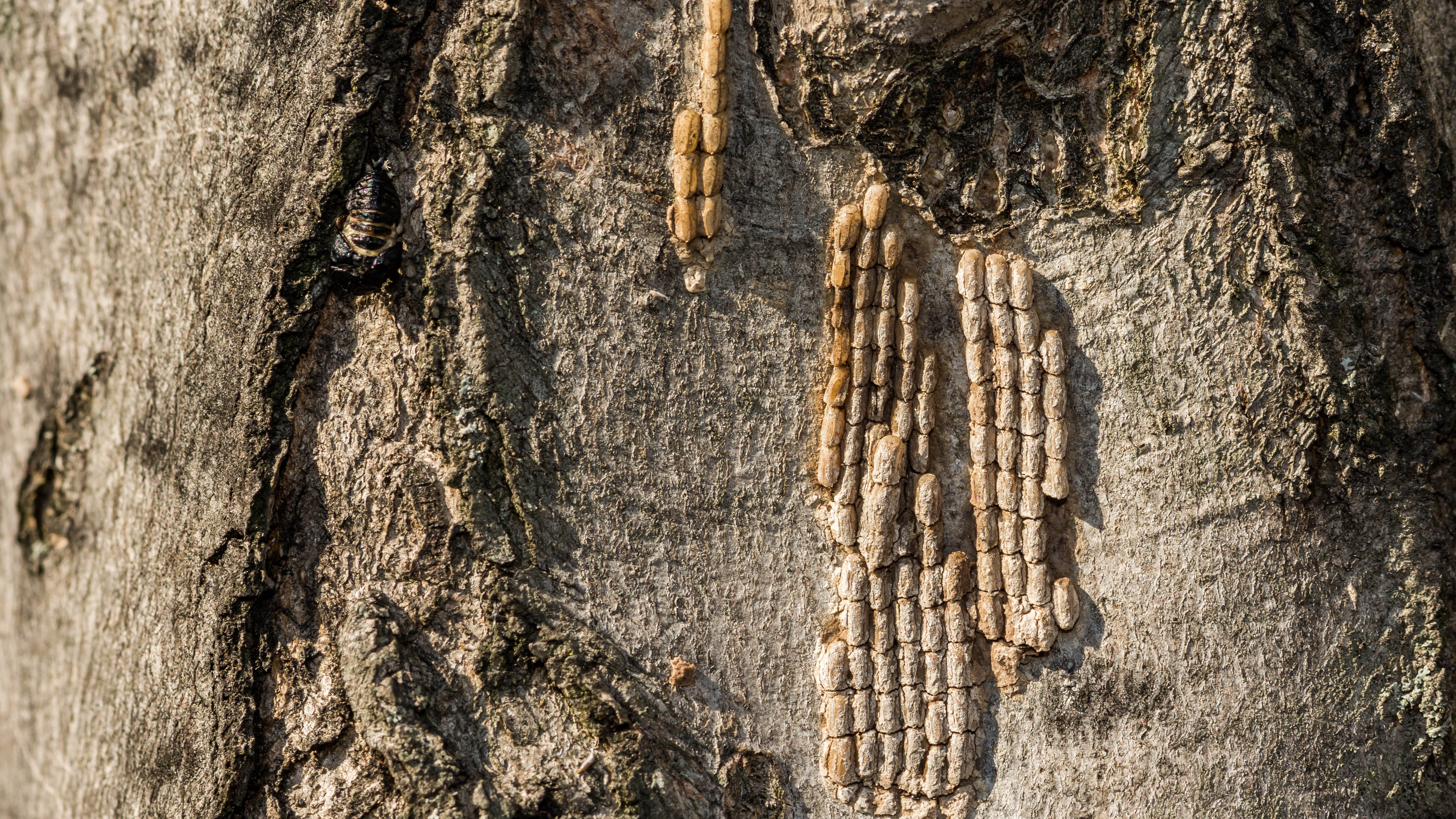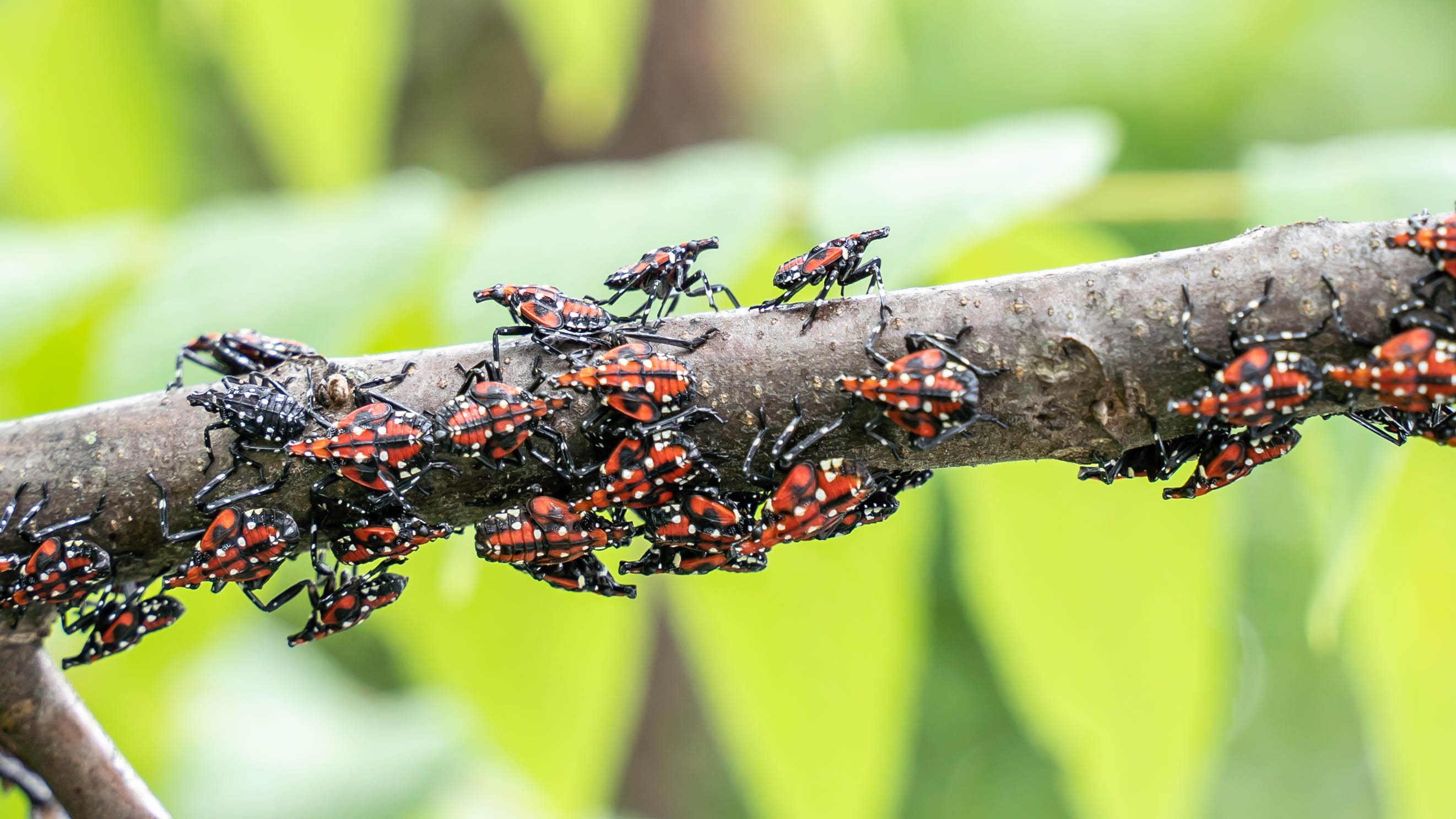7 ways to get rid of spotted lanternflies

If you’ve seen spotted lanternflies on your property, you’ll need to get rid of them fast. While these tiny bugs may look harmless, they can cause damage to your plants or crops.
The first thing to know about the Spotted Lanternfly (SLF) is that it’s not actually a fly. Emma Grace Crumbley, entomologist at Mosquito Squad, tells us that it’s yet another insect that ends in “fly” (like dragonfly, damselfly, and scorpionfly), that’s not a true fly. “Spotted lanternflies are members of the order Hemiptera, the insect order for ‘true bugs,’” she says. “Hemipterans are known for their piercing/sucking mouthparts, which they use to suck fluids from plants and other insects.”
Depending on their stage of life, spotted lanternflies are also commonly mistaken for ticks, stink bugs, tiger moths, tiger bee flies, boxelder and milkweed bugs, and giant leopard moths. But in the case of spotted lanternflies, they attack a variety of vegetation, ornamental nursery plants and several tree species.
That's why it's so important to know how to banish these problematic bugs. So, if you have these in your yard, check out our 7 ways to get rid of spotted lanternflies.
1. Identify early and often

According to Gene Caballero, co-founder of GreenPal in Nashville, TN, the first step is to identify spotted lanternflies as soon as possible. “Monitor your property for egg masses, nymphs, and adults,” he says. “Egg masses appear as grayish, mud-like encrustations often found on smooth surfaces like trees, stones, and outdoor furniture.”
In the early nymph stage, they are black with white spots and then transition to a red body with black stripes and white dots. Adults have black bodies with gray wings that have black spots and tips (they also have red underwings).
2. Remove eggs

If you find any egg masses, Caballero says you can scrape them off using a plastic card or a knife, then place them in a bag filled with rubbing alcohol or hand sanitizer to kill them.
Get instant access to breaking news, the hottest reviews, great deals and helpful tips.
David Price, associate certified entomologist and director of technical services at Mosquito Joe, agrees that you can scrape them off with a plastic card or putty knife and then place in a bag or container with rubbing alcohol. However, he says they can also be scraped off and then smashed or burned. “However, ensure all the eggs are destroyed,” Price advises. If you find spotted lanternflies on the ground, you can simply stomp on them.
You can also vacuum up the pesky insects, and a shop vacuum is particularly effective for this. Adding dishwashing liquid and water to the vacuum’s water reservoir helps to drown them.
3. Trap them

Just as you can use sticky traps to catch other types of insects, giant sticky traps can be used to trap spotted lanternflies. “Sticky bands around trees can be used to trap nymphs as they crawl up the trunk,” says Christopher S. Raimondi, CEO/president at Raimondi Horticultural Group in Ho-Ho-Kus, NJ. This view is shared by Caballero, who adds, “Tree banding with sticky tape can be effective during the early nymph stage, and you can also use insect traps specifically designed for spotted lanternflies.”
Since these insects tend to move up and down the tree during the day, placing sticky bands around four feet from the bottom of the tree has been effective in capturing them. However, you may want to enclose the sticky area with wiring to avoid inadvertently trapping birds and other wildlife.
4. Use insecticides

While spotted lanternflies aren’t harmful to humans, you may not want to get close enough to scrape them. “Treat infested trees with systemic insecticides or contact-based insecticides,” says Caballero, adding that you should always follow the manufacturer’s application instructions.
Bark spray, root drenches and trunk injections are various ways to effectively apply insecticide. However, make sure that your insecticide doesn’t include chemicals that could also damage the tree.
Another option, suggested by Raimondi, is to use biological control agents such as parasitoids. They live inside of or in close proximity to the host, and eventually kill it.
5. Remove host plants

Removing the host is another way to get rid of spotted lanternflies. “They have a preference for Tree of Heaven (Ailanthus altissima),” says Caballero. Tree of Heaven is itself an invasive species that prevents other types of trees from growing.
If possible, he says you can remove this tree under the guidance of a professional arborist.
6. Apply natural remedies

Spraying apple cider vinegar, neem oil, or essential oils like peppermint, lavender, and eucalyptus oil can also be a deterrent, since spotted lanternflies hate the smell of these products.
What's more, the strong smell of lavender can repel other common household pests such as mice, earwigs, and even cats in your yard.
7. Check your goods

Spotted lanternflies can be spread by human transportation. When you buy new plants, check to be sure you’re not bringing home unwanted guests.
The same goes for outdoor furniture. Spotted lanternflies can also be hiding in parked vehicles, so check them as well.
Call in professionals and report sightings

If you have a large infestation of spotted lanternflies however, you might want to contact a professional pest control service to handle the problem.
In addition, whenever you see spotted lanternflies, Caballero recommends reporting them to your state’s Department of Agriculture or local extension office. This helps officials keep track of them, and determine where they have expanded to.
What damage can lanternflies cause?
If left untreated, lanternflies are known to cause damage to plants and homegrown crops. “Spotted lanternflies feed voraciously on many economically important crops like grapevines, hops, ornamental nursery plants, and several tree species,” says Raimondi.
He explains that heavy spotted lanternfly feeding has contributed to the death of grapevines, the invasive tree Ailanthus altissima (tree-of-heaven, or TOH), and black walnut saplings. “While spotted lanternfly feeding can stress plants and cause localized branch damage, it is not known to directly kill other plants.” However, since feeding is considered a plant stressor, Raimondi says this may contribute to the long-term weakening of established plants and trees.
They’re problematic enough that in June, 2023, the U.S. Department of Agriculture’s Animal and Plant Health Inspection Service (APHIS) released a five-year strategy to combat the spotted lanternfly, which was first detected in North America in Berks County, Pennsylvania, and is now in 14 states. There’s a chance that between 2027 and 2033, it could reach the West Coast and destroy a variety of crops, including grapes, apples, hops, almonds, peaches, and walnuts.
More from Tom's Guide
- Here's how to get rid of fruit flies fast
- Or how to get rid of mealybugs and protect plants
- Check out 5 ways to get rid of ticks from your yard

Terri is a freelance writer living in Birmingham, AL. She is an experienced mattress and bedding product reviewer, and has tested hundreds of home and tech products, with bylines at Architectural Digest, Popular Science, CNN Underscored, NBC News, The Daily Beast, USA Today, Homes & Gardens, Bob Vila, and Tom's Guide.
